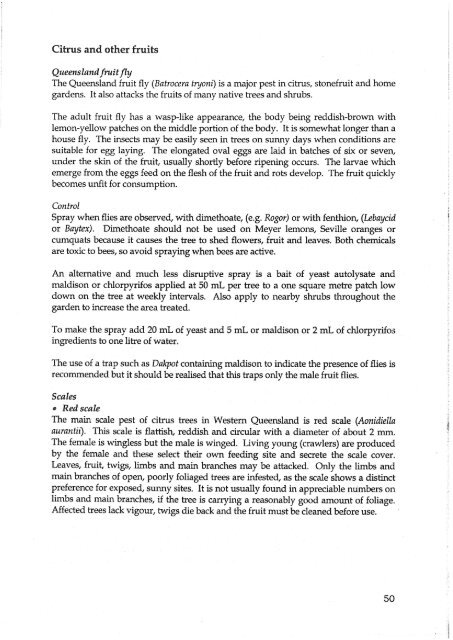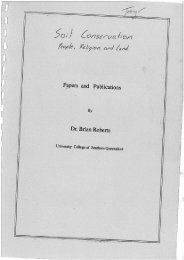western-queensland-gardening-guide.pdf - South West NRM
western-queensland-gardening-guide.pdf - South West NRM
western-queensland-gardening-guide.pdf - South West NRM
You also want an ePaper? Increase the reach of your titles
YUMPU automatically turns print PDFs into web optimized ePapers that Google loves.
Cihaas and sther fruits<br />
Queensland fruitfly<br />
The Queensland fruit fly (Batrocera tryoni) is a major pest in citrus, stonefruit and home<br />
gardens. It also attacks the fruits of many native trees and shrubs.<br />
The adult fruit fly has a wasp-like appearance, the body being reddish-brown with<br />
lemon-yellow patches on the middle portion of the body. It is somewhat longer than a<br />
house fly. The insects may be easily seen in trees on sunny days when conditions are<br />
suitable for egg laying. The elongated oval eggs are laid in batches of six or seven,<br />
under the skin of the fruit, usually shortly before ripening occurs. The larvae which<br />
emerge from the eggs feed on the flesh of the fruit and rots develop. The fruit quickly<br />
becomes unfit for consumption.<br />
Control<br />
Spray when flies are observed, with dimethoate, (e.g. Xogor) or with fenthion, (Lebaycid<br />
or Baytex). Dimethoate should not be used on Meyer lemons, Seville oranges or<br />
cumquats because it causes the tree to shed flowers, fruit and leaves. Both chemicals<br />
are toxic to bees, so avoid spraying when bees are active.<br />
An alternative and much less disruptive spray is a bait of yeast autolysate and<br />
maldison or chlorpyrifos applied at 50 mL per tree to a one square metre patch low<br />
down on the tree at weekly intervals. Also apply to nearby shrubs throughout the<br />
garden to increase the area treated.<br />
To make the spray add 20 mL of yeast and 5 mL or maldison or 2 mL of chlorpyrifos<br />
ingredients to one litre of water.<br />
The use of a trap such as Dakpot containing maldison to indicate the presence of flies is<br />
recommended but it should be realised that this traps only the male fruit flies.<br />
Sca les<br />
Redscale<br />
The main scale pest of citrus trees in <strong>West</strong>ern Queensland is red scale (Aonidiella<br />
aurantii). This scale is flattish, reddish and circular with a diameter of about 2 mm.<br />
The female is wingless but the male is winged. Living young (crawlers) are produced<br />
by the female and these select their own feeding site and secrete the scale cover.<br />
Leaves, fruit, twigs, limbs and main branches may be attacked. Only the limbs and<br />
main branches of open, poorly foliaged trees are infested, as the scale shows a distinct<br />
preference for exposed, sunny sites. It is not usually found in appreciable nuinbers on<br />
limbs and main branches, if the tree is carrying a reasonably good amount of foliage.<br />
Affected trees lack vigour, twigs die back and the fruit must be cleaned before use.
















